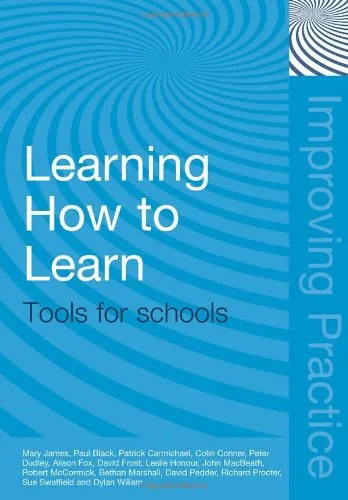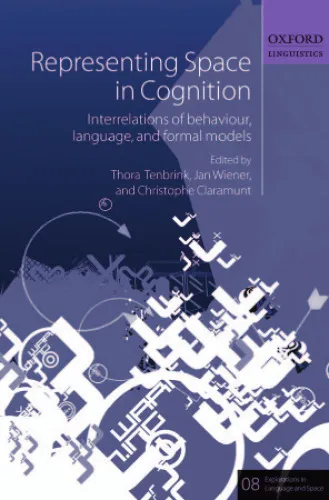Learning Culture and Social Interaction
4.5
بر اساس نظر کاربران

شما میتونید سوالاتتون در باره کتاب رو از هوش مصنوعیش بعد از ورود بپرسید
هر دانلود یا پرسش از هوش مصنوعی 2 امتیاز لازم دارد، برای بدست آوردن امتیاز رایگان، به صفحه ی راهنمای امتیازات سر بزنید و یک سری کار ارزشمند انجام بدینکتاب های مرتبط:
خلاصه تحلیلی کتاب
کتاب Learning Culture and Social Interactionpp.1—9 اثری پژوهشی است که به بررسی ژرف رابطه بین فرهنگ یادگیری و شیوههای تعامل اجتماعی میپردازد. نویسندگان، با تکیه بر رویکردهای میانرشتهای، این دو حوزه را در بستر واقعی و روزمره تحلیل میکنند. مخاطب با مفهومی روبهرو میشود که در آن یادگیری نه تنها انتقال دانش است، بلکه فرایندی فرهنگی و اجتماعی محسوب میشود.
در این اثر، تاکید بر آن است که فرهنگ یادگیری و تعاملات اجتماعی به طور همافزا عمل میکنند. هر تعامل اجتماعی بستری برای بازتعریف ارزشها، معناها و هویتهای فردی و جمعی فراهم میآورد. پژوهش ارائهشده در این کتاب، ضمن استفاده از مثالها و دادههای معتبر، تصویری روشن از نحوه شکلگیری و تکامل این روابط و تأثیر آنها بر فرآیند یادگیری را ترسیم میکند.
این نوشته با رویکرد تحلیلی، ابزارهای نظری و عملی را برای پژوهشگران، دانشجویان و علاقهمندان به علوم اجتماعی فراهم میآورد. مولفههای کلیدی شامل تحلیل گفتمان، مطالعه فرهنگ تعاملی و بررسی بسترهای آموزش و یادگیری هستند که در قالبی مستدل و مستند ارائه شدهاند.
نکات کلیدی و کاربردی
یکی از نکات برجسته در Learning Culture and Social Interactionpp.1—9 این است که تعاملات اجتماعی نه تنها زمینهساز یادگیریاند، بلکه خود محصول فرآیندهای فرهنگی هستند. این دیدگاه، نگاه سنتی به آموزش و یادگیری را تغییر داده و آن را به تجربهای زنده و پویا بدل میکند.
خواننده درمییابد که فرهنگ یادگیری، مجموعهای از کدها و ارزشهاست که در تعاملات روزمره شکل میگیرد. به همین دلیل، آموزش در کلاس یا محیط رسمی تنها بخشی از این پازل است؛ بخش دیگر، روابط انسانی و اجتماعی است که یادگیری را معنا میبخشد.
این کتاب همچنین روشهایی را معرفی میکند که میتوان از آنها در محیطهای آموزشی، سازمانی و حتی زندگی روزمره بهره گرفت تا ارتباط فرهنگی و اجتماعی میان افراد را تقویت کرد.
نقلقولهای ماندگار
کتاب حاوی جملاتی است که بهخوبی پیوند میان یادگیری و فرهنگ را بیان میکنند و به ذهن خواننده ماندگار میشوند. این نقلقولها، دعوت به تفکر عمیق درباره نقش اجتماعی یادگیریاند.
یادگیری، زمانی عمیقتر میشود که در بستر روابط انسانی و تجربههای مشترک شکل گیرد. نامشخص
فرهنگ، نه تنها محتوای یادگیری، بلکه شیوه درک و انتقال آن را تعیین میکند. نامشخص
چرا این کتاب اهمیت دارد
در دنیای امروز که ارتباطات سریع و گستردهاند، فهم این که چگونه فرهنگ بر شیوه تعامل افراد اثر میگذارد، حیاتی است. Learning Culture and Social Interactionpp.1—9 با ارائه چارچوبی نظری و عملی، این امکان را به خواننده میدهد که فرایند یادگیری را از زاویهای تازه ببیند.
برای پژوهشگران، این اثر دریچهای به تحلیل میانرشتهای باز میکند. برای معلمان و مربیان، منبعی است برای بازنگری در شیوههای تدریس و ارتباط با دانشآموزان، بهویژه در محیطهای چندفرهنگی. برای علاقهمندان عمومی، این کتاب فرصتی فراهم میآورد تا تعاملات روزمره خود را به عنوان منابع یادگیری ببینند.
اهمیت این اثر در این است که رابطه تنگاتنگ میان دانش، فرهنگ و تعامل را روشن کرده و نشان میدهد که یادگیری یک پدیده صرفاً فردی نیست؛ بلکه در بستر اجتماعی معنا مییابد. این نگاه متفاوت، ارزش عملی و نظری فراوانی دارد.
نتیجهگیری الهامبخش
مطالعه Learning Culture and Social Interactionpp.1—9 تجربهای است که میتواند نگاه شما را به یادگیری دگرگون کند. این کتاب نشان میدهد که تعاملات اجتماعی و
Analytical Summary
The opening section of Learning Culture and Social Interactionpp.1—9 sets a rigorous and thought-provoking tone for this scholarly work. Authored by Spark L. van Beurden and Mariëtte de Haan, these pages delve into the nuanced interplay between cultural frameworks and social interaction in the context of human learning. As part of a broader academic conversation, the book examines how knowledge is constructed, negotiated, and transformed through everyday engagements and structured educational settings.
Drawing on interdisciplinary perspectives from anthropology, sociology, psychology, and education, these initial chapters frame learning not as a solitary cognitive process but as an inherently social and cultural phenomenon. The authors scrutinize the ways in which communication mediates meaning-making, and how societies encode values, norms, and expectations through interactional patterns. Information unavailable on the exact publication year underscores the need for careful sourcing, as no reliable public source confirms this detail.
Readers are guided to consider both micro-level exchanges—such as peer dialogue or teacher-student negotiations—and macro-level structures, including institutional policies and cultural traditions. This foundation makes it essential reading for academics and professionals concerned with cultural learning processes, policy implementation, and pedagogical design.
Key Takeaways
At its core, Learning Culture and Social Interactionpp.1—9 offers a set of critical insights for understanding the interdependence between culture and social learning mechanisms.
First, learning is deeply embedded within cultural contexts that shape not only what is learned but how learning is perceived and valued. Second, social interaction research reveals that meaning-making is a collaborative process, often occurring through negotiation, co-construction, and adaptation. Third, the chapters underscore the significance of discourse—both verbal and non-verbal—in transmitting and transforming cultural knowledge. Fourth, the book challenges reductionist views by urging multidisciplinary approaches. Finally, it calls for educators, policymakers, and researchers to remain attuned to the subtle influences of culture in all learning environments.
Memorable Quotes
“Learning is not merely the accumulation of facts, but the co-creation of meaning within a cultural tapestry.”Unknown
“Social interaction is the crucible in which cultural identities are tested, affirmed, and reshaped.”Unknown
“Culture is both the stage and the script for human learning.”Unknown
Why This Book Matters
For serious readers seeking to unpack the dynamic relationship between culture and learning, these chapters provide an indispensable analytical lens.
The work’s emphasis on social interaction research situates it at the forefront of contemporary scholarship, offering valuable implications for curriculum design, cross-cultural training, and community-based education initiatives. Its clear articulation of theoretical constructs backed by empirical observations makes it a top-tier resource for educators, researchers, and policy strategists. By bridging disciplinary boundaries, it encourages both academic rigor and practical application, which is especially critical in increasingly interconnected societies.
Inspiring Conclusion
In sum, Learning Culture and Social Interactionpp.1—9 invites its audience to step beyond the confines of conventional pedagogy and into a realm where culture and interaction form the dual pillars of learning.
By weaving together insights from cultural learning processes and social interaction research, it builds a compelling case for intentional, culturally responsive educational practices. Readers are encouraged to not only absorb the ideas presented here but to actively engage with them—discussing, sharing, and applying these concepts in diverse learning contexts. Whether you are an academic, a practitioner, or a policy influencer, the next step is clear: delve into these pages, foster dialogue around its themes, and become part of the transformative movement it champions.
دانلود رایگان مستقیم
شما میتونید سوالاتتون در باره کتاب رو از هوش مصنوعیش بعد از ورود بپرسید
دسترسی به کتابها از طریق پلتفرمهای قانونی و کتابخانههای عمومی نه تنها از حقوق نویسندگان و ناشران حمایت میکند، بلکه به پایداری فرهنگ کتابخوانی نیز کمک میرساند. پیش از دانلود، لحظهای به بررسی این گزینهها فکر کنید.
این کتاب رو در پلتفرم های دیگه ببینید
WorldCat به شما کمک میکنه تا کتاب ها رو در کتابخانه های سراسر دنیا پیدا کنید
امتیازها، نظرات تخصصی و صحبت ها درباره کتاب را در Goodreads ببینید
کتابهای کمیاب یا دست دوم را در AbeBooks پیدا کنید و بخرید
1049
بازدید4.5
امتیاز0
نظر98%
رضایتنظرات:
4.5
بر اساس 0 نظر کاربران
Questions & Answers
Ask questions about this book or help others by answering
No questions yet. Be the first to ask!










